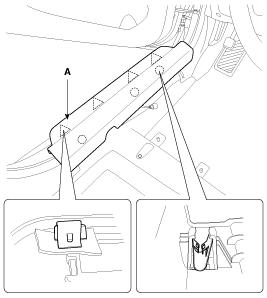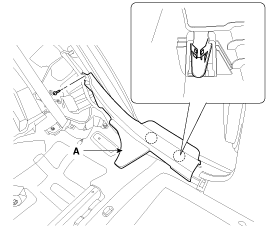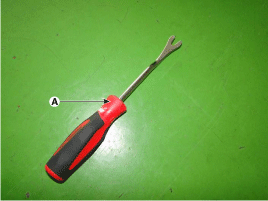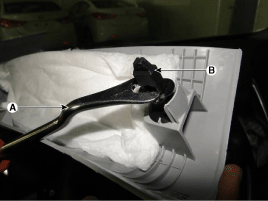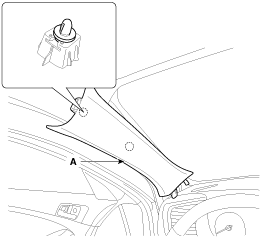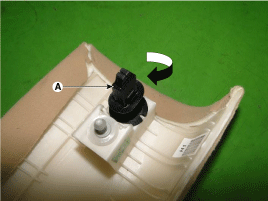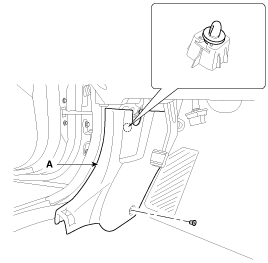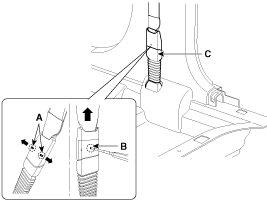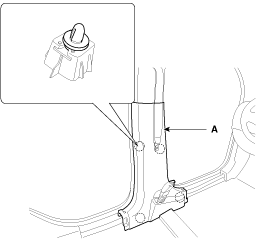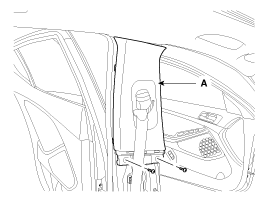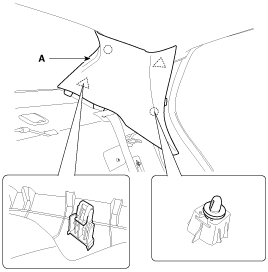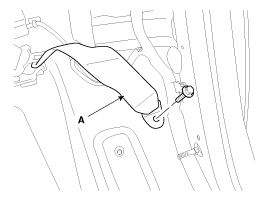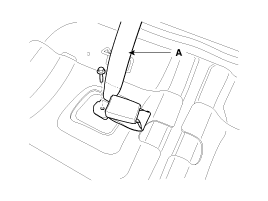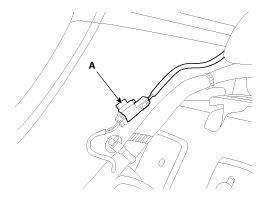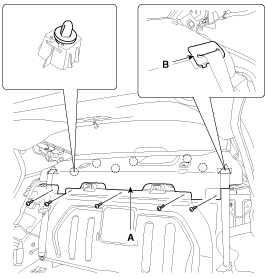Kia Optima Hybrid: Interior / Interior Trim Repair procedures
Door Scuff Trim Replacement
•
Put on gloves to protect your hands.
•
Use a plastic panel removal tool to remove interior trim pieces to protect from marring the surface.
•
Take care not to bend or scratch the trim and panels.
1.
Using a screwdriver or remover, remove the front door scuff tirm (A).
[Front]
2.
Remove the rear seat cushion.
(Refer to the BD group - "Rear Seat")
3.
After loosening the mounting screw, then remove rear door scuff trim (A).
[Rear]
4.
Installation is the reverse of removal.
•
Replace any damaged clips.
Front Pillar Trim Replacement
•
Put on gloves to protect your hands.
•
Use a plastic panel removal tool to remove interior trim pieces to protect from marring the surface.
•
Take care not to bend or scratch the trim and panels.
1.
Remove the front pillar trim.
(1)
To remove the front pillar trim, the below tool (A) must be used.
(2)
Slightly spread open the front pillar trim and then place the tool (A) on the mounting clip (B) like the picture below.
After placing the tool (A) on the mounting clip (B) push it to the front.
•
Once the front pillar trim has been removed, replace the clips to new ones.
(3)
Remove the front pillar trim (A).
•
Remove the mounting clip (A) by turning it clockwise.
2.
Installation is the reverse of removal.
Cowl Side Trim Replacement
•
Put on gloves to protect your hands.
•
Use a plastic panel removal tool to remove interior trim pieces to protect from marring the surface.
•
Take care not to bend or scratch the trim and panels.
1.
Remove the front door scuff trim.
2.
Remove the hood latch release handle.
(Refer to the BD group - "Hood")
3.
Detach the clips, then remove the cowl side trim (A).
4.
Installation is the reverse of removal.
•
Replace any damaged clips.
Center Pillar Trim Replacement
•
Put on gloves to protect your hands.
•
Use a plastic panel removal tool to remove interior trim pieces to protect from marring the surface.
•
Take care not to bend or scratch the trim and panels.
1.
Remove the front door scuff trim and rear door scuff trim.
2.
To remove the seat belt anchor pretensioner (C), keep on pushing the lock pins (A) as arrow direction.
And then remove the seat belt after pushing the lock pin (B).
3.
Remove the center pillar lower trim (A).
4.
After loosening the mounting screws, then remove the center pillar upper trim (A).
5.
Installation is the reverse of removal.
•
Replace any damaged clips.
Rear Pillar Trim Replacement
•
Put on gloves to protect your hands.
•
Use a plastic panel removal tool to remove interior trim pieces to protect from marring the surface.
•
Take care not to bend or scratch the trim and panels.
1.
Using a screwdriver or remover, remove the rear pillar trim (A).
2.
Installation is the reverse of removal.
•
Replace any damaged clips.
Package Tray Trim Replacement
•
Put on gloves to protect your hands.
•
Use a plastic panel removal tool to remove interior trim pieces to protect from marring the surface.
•
Take care not to bend or scratch the trim and panels.
1.
Remove the rear seat assembly.
(Refer to the BD group - "Rear Seat")
2.
After loosening the mounting bolt, then remove the rear seat belt lower anchor (A).
[LH, RH]
Tightening torque:
39.2 ~ 53.9 N.m (4.0 ~ 5.5 kgf.m, 28.8 ~ 39.8 lb-ft)
[Center]
Tightening torque:
39.2 ~ 53.9 N.m (4.0 ~ 5.5 kgf.m, 28.8 ~ 39.8 lb-ft)
3.
Using a screwdriver or remover, remove the rear pillar trim (A).
4.
Disconnect the connector (A).
5.
Using a screwdriver or remover, remove the rear seat belt cover (B).
6.
After loosening the mounting screws, then remove the package tray trim (A).
7.
Installation is the reverse of removal.
•
Replace any damaged clips.
•
Make sure the connector is connected properly.
Components 1. Front pillar trim2. Center pillar upper trim3. Center pillar lower trim4. Rear pillar trim5. Cowl side trim6. Front door scuff trim7. Rear door scuff trim8. Rear package tray trim ...
Replacement • Put on gloves to protect your hands. • Use a plastic panel removal tool to remove interior trim pieces to protect from marring the surface. • Take care not to bend or ...
Other information:
Component Location 1. Cap2. Nut3. Wiper arm & blade4. Rivet5. Cowl top cover6. Bolt7. Wiper motor & linkage assembly ...
Component Location 1. Virtual engine sound system unit2. Virtual engine sound speaker ...
© 2025 Copyright www.koptimatfhev.com
 Interior Trim Components and Components Location
Interior Trim Components and Components Location Trunk Trim Repair procedures
Trunk Trim Repair procedures

